Author : Rumana Reza
On my previous post, some basic or primary ideas like state of matters,atom,Bohr model, atomic orbital,chemical bond,Quantum state were briefly highlighted. Here we are going to understand their types more closely.
Particle Physics
All elementary particles are—depending
on their spin—either bosons or fermions. These are
differentiated via the spin–statistics
theorem of quantum
statistics.
Particles of half-integer spin exhibit Fermi–Dirac
statisticsand
are fermions.Particles of integer spin, in other words
full-integer, exhibit Bose–Einstein
statistics and are bosons.
Elementary
fermions:
·
Matter
particles
·
Quarks:
·
up, down
·
charm, strange
·
top, bottom
·
Leptons:
·
electron, electron neutrino (a.k.a.,
"neutrino")
·
muon, muon neutrino
·
tau, tau neutrino
·
Antimatter particles
·
Antiquarks
·
Antileptons
Elementary
bosons:
·
Force particles (gauge bosons):
·
photon
·
gluon (numbering eight)
·
W+, W−,
and Z0 bosons
·
graviton (hypothetical)
·
Scalar boson
·
Higgs boson
 |
| Graphic representation of the standard model of elementary particles. Spin, charge, approximate mass and participation in different force interactions are shown. by Zhitelew |
Description
Mass:
Spin (small blue circles in the middle):
empty circle: 0
full circle: 1
half-circle: 1/2
Charge (external circles):
2/3 circle: 2/3 or -2/3 respectively
1/3 circle: 1/3 or -1/3 respectively
Note the similarities in distribution of charges between the left and the right sides of the diagram.
Participation in interactions:
more than 80 GeV/c^2
1-5 GeV/c^2
90-110 MeV/c^2
less than 16 MeV/c^2
Massless
Note the gradual increase of mass from the periphery to the center (with possible exception of neutrinos). Also note the similarities in distribution of masses between the left and the right sides of the diagram.Spin (small blue circles in the middle):
empty circle: 0
full circle: 1
half-circle: 1/2
Charge (external circles):
positive
negative
full circle: 1 or -1 respectively2/3 circle: 2/3 or -2/3 respectively
1/3 circle: 1/3 or -1/3 respectively
Note the similarities in distribution of charges between the left and the right sides of the diagram.
Participation in interactions:
Weak force (note: only particles with non-zero mass are here)
Electromagnetic force
Strong force
Note the bilateral symmetry.
Matter Wave:
- The wave-like behavior of matter is crucial to the modern theory of atomic structure and particle physics.All matter can exhibit wave-like behavior. For example a beam of electrons can be diffracted just like a beam of light or a water wave.Matter waves are a central part of the theory of quantum mechanics, being an example of wave–particle duality. The concept that matter behaves like a wave is also referred to as the de Broglie hypothesis. Matter waves are often referred to as de Broglie waves.
The de Broglie wavelength is the wavelength, λ, associated with a massive particle and is related to its momentum, p, through the Planck constant, h:

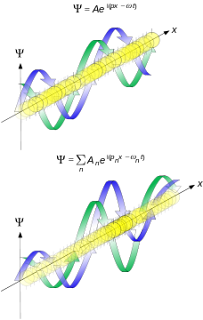 |
| Propagation of a de broglie wave byMaschen |
Electron:
The electron is a subordinate particle, symbol e− or β−, with a negative elementary electric
charge. Electrons belong to the first generation of the lepton
particle family, and are generally thought to be elementary particles because
they have no known components or substructure.Being fermions, no two electrons can occupy the same quantum state, in accordance with the Pauli exclusion principle.Like all matter, electrons have properties of both particles and waves, and so can collide with other particles and can be diffracted like light. The wave properties of electrons are easier to observe with experiments than those of other particles like neutrons and protons.Many physical phenomena involve electrons in an essential role, such as electricity, magnetism, and thermal conductivity, and they also participate in gravitational, electromagnetic and weak interactions. An electron generates an electric fieldsurrounding it. An electron moving relative to an observer generates a magnetic field.
 |
Proton:
The proton is a subatomic particle, symbol p or p+, with a positive electric charge of +1e elementary charge and mass slightly less than that of a neutron.The nucleus consists of Z protons, where Z is called the atomic number, The atomic number defines the chemical properties of the atomOne or more protons are present in the nucleus of an atom. Although the proton was originally considered a fundamental particle, it is composed of three valence quarks: two up quarks and one down quark.
Hydrogen ion

Protium, the most common isotope of hydrogen, consists of one proton and one electron (it has no neutrons). The term "hydrogen ion" (H+) implies that that H-atom has lost its one electron, causing only a proton to remain. Thus, in chemistry, the terms "proton" and "hydrogen ion" (for the protium isotope) are used synonymously
The proton is a "bare charge" with only about 1/64,000 of the radius of a hydrogen atom, and so is extremely reactive chemically. The free proton, thus, has an extremely short lifetime in chemical systems such as liquids and it reacts immediately with the electron cloud of any available molecule.
The ion produced by removing the electron from a deuterium atom is known as a deuteron, not a proton. Likewise, removing an electron from a tritium atom produces a triton.
Human exposure
The Apollo Lunar Surface Experiments Packages (ALSEP) determined that more than 95% of the particles in the solar wind are electrons and protons, in approximately equal numbers.Because the Solar Wind Spectrometer made continuous measurements, it was possible to measure how the Earth's magnetic field affects arriving solar wind particles. For about two-thirds of each orbit, the Moon is outside of the Earth's magnetic field. At these times, a typical proton density was 10 to 20 per cubic centimeter, with most protons having velocities between 400 and 650 kilometers per second. For about five days of each month, the Moon is inside the Earth's geomagnetic tail, and typically no solar wind particles were detectable. For the remainder of each lunar orbit, the Moon is in a transitional region known as the magnetosheath, where the Earth's magnetic field affects the solar wind but does not completely exclude it. In this region, the particle flux is reduced, with typical proton velocities of 250 to 450 kilometers per second. During the lunar night, the spectrometer was shielded from the solar wind by the Moon and no solar wind particles were measured.
Protons also occur in from extra solar origin in space, from galactic cosmic rays, where they make up about 90% of the total particle flux. These protons often have higher energy than solar wind protons, but their intensity is far more uniform and less variable than protons coming from the Sun, the production of which is heavily affected by solar proton events such as coronal mass ejections.
Neutron:
The neutron is a subatomic particle, symbol n or n0, with no net electric charge and a mass slightly larger than that of a proton .The nucleus consists of N neutrons, where N is the neutron number.
The neutron number determines the isotope or nuclide. The terms isotope and nuclide are often used synonymously, but they refer to chemical and nuclear properties, respectively.The neutron is essential to the production of nuclear power and was used to effect many different types of nuclear transmutations. With the discovery of nuclear fission in 1938,it was quickly realized that, if a fission event produced neutrons, each of these neutrons might cause further fission events, etc., in a cascade known as a nuclear chain reaction.These events and findings led to the first self-sustaining nuclear reactor (Chicago Pile-1, 1942) and the first nuclear weapon (Trinity, 1945).
Neutron compounds:
Dineutrons and tetraneutrons
The existence of stable clusters of 4 neutrons, or tetraneutrons, has been hypothesized by a team led by Francisco-Miguel Marqués at the CNRS Laboratory for Nuclear Physics based on observations of the disintegration of beryllium-14 nuclei. This is particularly interesting because current theory suggests that these clusters should not be stable.
The dineutron is another hypothetical particle. In 2012, Artemis Spyrou from Michigan State University and coworkers reported that they observed, for the first time, the dineutron emission in the decay of 16Be. The dineutron character is evidenced by a small emission angle between the two neutrons. The authors measured the two-neutron separation energy to be 1.35(10) MeV, in good agreement with shell model calculations, using standard interactions for this mass region.Neutronium and neutron stars
At extremely high pressures and temperatures, nucleons and electrons are believed to collapse into bulk neutronic matter, called neutronium. This is presumed to happen in neutron stars.The extreme pressure inside a neutron star may deform the neutrons into a cubic symmetry, allowing tighter packing of neutrons.
Fermions:
A fermion can be an elementary particle, such as the electron, or it can be a composite particle, such as the proton. Fermions are particles with half-integer spin. As a consequence of the Pauli exclusion principle, only one fermion can occupy a particular quantum state at any given time. If multiple fermions have the same spatial probability distribution, then at least one property of each fermion, such as its spin, must be different. Fermions are usually associated with matter.At low temperature fermions show superfluidity for uncharged particles and superconductivity for charged particles.
Composite fermions, such as protons and neutrons, are the key building
blocks of everyday matter
In quantum
statistics, a branch of physics, Fermi–Dirac
statistics describes a
distribution of particles over energy states in systems consisting of many identical
particles that obey
the Pauli
exclusion principle.
Fermi–Dirac (F–D)
statistics applies to identical particles with half-integer spin in a system in thermodynamic
equilibrium.
Additionally, the particles in this system are assumed to have negligible
mutual interaction. This allows the many-particle system to be described in
terms of single-particle energy states. The result is the F–D distribution of
particles over these states and includes the condition that no two particles
can occupy the same state, which has a considerable effect on the properties of
the system. Since F–D statistics applies to particles with half-integer spin,
these particles have come to be called fermions. It is most commonly applied to electrons, which are fermions with spin 1/2.
 |
| Antisymmetric wavefunction for a (fermionic) 2-particle state in an infinite square well potential TimothyRias - Own work |
Elementary fermions
The Standard Model recognizes two types of elementary fermions, quarks and leptons. In all, the model distinguishes 24 different fermions. There are six quarks (up, down, strange, charm, bottom and top quarks), and six leptons (electron, electron neutrino, muon, muon neutrino, tau particle and tau neutrino), along with the corresponding antiparticle of each of these.Mathematically, fermions come in three types - Weyl fermions (massless), Dirac fermions (massive), and Majorana fermions (each its own antiparticle). Most Standard Model fermions are believed to be Dirac fermions, although it is unknown at this time whether the neutrinos are Dirac or Majorana fermions. Dirac fermions can be treated as a combination of two Weyl fermions. So far there is no known example of Weyl fermion in particle physics. In July 2015, Weyl fermions have been experimentally realized in Weyl semimetals.
Composite fermions
Composite particles (such as hadrons, nuclei, and atoms) can be bosons or fermions depending on their constituents. More precisely, because of the relation between spin and statistics, a particle containing an odd number of fermions is itself a fermion. It will have half-integer spin.Examples include the following:
- A baryon, such as the proton or neutron, contains three fermionic quarks and thus it is a fermion.
- The nucleus of a carbon-13 atom contains six protons and seven neutrons and is therefore a fermion.
- The atom helium-3 (3He) is made of two protons, one neutron, and two electrons, and therefore it is a fermion.
Fermionic or bosonic behavior of a composite particle (or system) is only seen at large (compared to size of the system) distances. At proximity, where spatial structure begins to be important, a composite particle (or system) behaves according to its constituent makeup.
Fermions can exhibit bosonic behavior when they become loosely bound in pairs. This is the origin of superconductivity and the superfluidity of helium-3: in superconducting materials, electrons interact through the exchange of phonons, forming Cooper pairs, while in helium-3, Cooper pairs are formed via spin fluctuations.
The quasiparticles of the fractional quantum Hall effect are also known as composite fermions, which are electrons with an even number of quantized vortices attached to them.
Skyrmions
| Standard Model of particle physics |
|---|
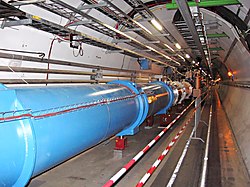
Large Hadron Collider tunnel at CERN
|
In a quantum field theory, there can be field configurations of bosons which are topologically twisted. These are coherent states (or solitons) which behave like a particle, and they can be fermionic even if all the constituent particles are bosons. The fermions made of bosons are named skyrmions after its discoverer Tony Skyrme
Skyrme's original example involved fields which take values on a three-dimensional sphere, the original nonlinear sigma model which describes the large distance behavior of prions. In Skyrme's model, reproduced in the large N or string approximation to quantum chromodynamics (QCD), the proton and neutron are fermionic topological solitons of the prion field.Whereas Skyrme's example involved pion physics, there is a much more familiar example in quantum electrodynamics with a magnetic monopole. A bosonic monopole with the smallest possible magnetic charge and a bosonic version of the electron will form a fermionic dyon.
The analogy between the Skyrme field and the Higgs field of the electroweak sector has been used to postulate that all fermions are skyrmions. This could explain why all known fermions have baryon or lepton quantum numbers and provide a physical mechanism for the Pauli exclusion principle.
Boson:
Particles with integer spin are bosons. They are generally force carrier particles.An important characteristic of bosons is that their statistics do not restrict the number of them that occupy the same quantum state. This property is exemplified by helium-4 when it is cooled to become a super-fluid. Unlike bosons, two identical fermions cannot occupy the same quantum space. Whereas the elementary particles that make up matter (i.e. leptons and quarks) are fermions, the elementary bosons are force carriers that function as the 'glue' holding matter together. This property holds for all particles with integer spin (s = 0, 1, 2 etc.) as a consequence of the spin–statistics theorem. When a gas of Bose particles is cooled down to absolute zero then the kinetic energy of the particles decreases to a negligible amount and they condense into a lowest energy level state. This state is called Bose-Einstein condensation. It is believed that this phenomenon is the secret behind super fluidity of liquids.
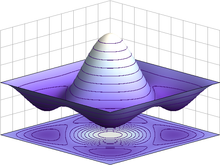 |
| Symmetric wavefunction for a (bosonic) 2-particle state in an infinite square well potential. |
Elementary bosons
All observed elementary particles are either fermions or bosons. The observed elementary bosons are all gauge bosons: photons, W and Z bosons, gluons, and the Higgs boson.
- Photons are the force carriers of the electromagnetic field.
- W and Z bosons are the force carriers which mediate the weak force.
- Gluons are the fundamental force carriers underlying the strong force.
- Higgs Bosons give other particles mass via the Higgs mechanism. Their existence was confirmed by CERN on 14 March 2013.
Composite bosons
Composite particles (such as hadrons, nuclei, and atoms) can be bosons or fermions depending on their constituents. More precisely, because of the relation between spin and statistics, a particle containing an even number of fermions is a boson, since it has integer spin.
Examples include the following:- Any meson, since mesons contain one quark and one anti quark.
- The nucleus of a carbon-12 atom, which contains 6 protons and 6 neutrons.
- The helium-4 atom, consisting of 2 protons, 2 neutrons and 2 electrons.
Antiparticle:
Corresponding to most kinds of particles, there is an associated antimatter antiparticle with the same mass and opposite charge (including electric charge). For example, the antiparticle of the electron is the positively charged electron, or positron, which is produced naturally in certain types of radioactive decay.
The laws of nature are very nearly symmetrical with respect to particles and antiparticles. For example, an antiproton and a positron can form an antihydrogen atom, which is believed to have the same properties as a hydrogen atom. This leads to the question of why the formation of matter after the Big Bang resulted in a universe consisting almost entirely of matter, rather than being a half-and-half mixture of matter and antimatter. The discovery of Charge Parity violation helped to shed light on this problem by showing that this symmetry, originally thought to be perfect, was only approximate.
Particle-antiparticle pairs can annihilate each other, producing photons; since the charges of the particle and antiparticle are opposite, total charge is conserved. For example, the positrons produced in natural radioactive decay quickly annihilate themselves with electrons, producing pairs of gamma rays, a process exploited in positron emission tomography.
Antiparticles are produced naturally in beta decay, and in the interaction of cosmic rays in the Earth's atmosphere. Because charge is conserved, it is not possible to create an antiparticle without either destroying a particle of the same charge (as in beta decay) or creating a particle of the opposite charge. The latter is seen in many processes in which both a particle and its antiparticle are created simultaneously, as in particle accelerators. This is the inverse of the particle-antiparticle annihilation process.
Although particles and their antiparticles have opposite charges, electrically neutral particles need not be identical to their antiparticles. The neutron, for example, is made out of quarks, the antineutron from antiquarks, and they are distinguishable from one another because neutrons and antineutrons annihilate each other upon contact. However, other neutral particles are their own antiparticles, such as photons, the hypothetical gravitons, and some WIMPs.
The laws of nature are very nearly symmetrical with respect to particles and antiparticles. For example, an antiproton and a positron can form an antihydrogen atom, which is believed to have the same properties as a hydrogen atom. This leads to the question of why the formation of matter after the Big Bang resulted in a universe consisting almost entirely of matter, rather than being a half-and-half mixture of matter and antimatter. The discovery of Charge Parity violation helped to shed light on this problem by showing that this symmetry, originally thought to be perfect, was only approximate.
Particle-antiparticle pairs can annihilate each other, producing photons; since the charges of the particle and antiparticle are opposite, total charge is conserved. For example, the positrons produced in natural radioactive decay quickly annihilate themselves with electrons, producing pairs of gamma rays, a process exploited in positron emission tomography.
Antiparticles are produced naturally in beta decay, and in the interaction of cosmic rays in the Earth's atmosphere. Because charge is conserved, it is not possible to create an antiparticle without either destroying a particle of the same charge (as in beta decay) or creating a particle of the opposite charge. The latter is seen in many processes in which both a particle and its antiparticle are created simultaneously, as in particle accelerators. This is the inverse of the particle-antiparticle annihilation process.
Although particles and their antiparticles have opposite charges, electrically neutral particles need not be identical to their antiparticles. The neutron, for example, is made out of quarks, the antineutron from antiquarks, and they are distinguishable from one another because neutrons and antineutrons annihilate each other upon contact. However, other neutral particles are their own antiparticles, such as photons, the hypothetical gravitons, and some WIMPs.
 |
| Illustration of electric charge of particles (left) and antiparticles (right). From top to bottom; electron/positron, proton/antiproton, neutron/antineutron. |
Hole theory
Solutions of the Dirac equation contained negative energy quantum states. As a result, an electron could always radiate energy and fall into a negative energy state. Even worse, it could keep radiating infinite amounts of energy because there were infinitely many negative energy states available. To prevent this nonphysical situation from happening, Dirac proposed that a "sea" of negative-energy electrons fills the universe, already occupying all of the lower-energy states so that, due to the Pauli exclusion principle, no other electron could fall into them. Sometimes, however, one of these negative-energy particles could be lifted out of this Dirac sea to become a positive-energy particle. But, when lifted out, it would leave behind a hole in the sea that would act exactly like a positive-energy electron with a reversed charge. These he interpreted as "negative-energy electrons" and attempted to identify them with protons in his 1930 paper A Theory of Electrons and Protons.
However, these "negative-energy electrons" turned out to be positrons, and not protons.
Dirac was aware of the problem that his picture implied an infinite negative charge for the universe. Dirac tried to argue that we would perceive this as the normal state of zero charge. Another difficulty was the difference in masses of the electron and the proton. Dirac tried to argue that this was due to the electromagnetic interactions with the sea, until Hermann Weyl proved that hole theory was completely symmetric between negative and positive charges.However, these "negative-energy electrons" turned out to be positrons, and not protons.
Dirac also predicted a reaction e− + p+ → γ + γ, where an electron and a proton annihilate to give two photons. Robert Oppenheimer and Igor Tamm proved that this would cause ordinary matter to disappear too fast. A year later, in 1931, Dirac modified his theory and postulated the positron, a new particle of the same mass as the electron. The discovery of this particle the next year removed the last two objections to his theory.
However, the problem of infinite charge of the universe remains. Also, as we now know, bosons also have antiparticles, but since bosons do not obey the Pauli exclusion principle (only fermions do), hole theory does not work for them. A unified interpretation of antiparticles is now available in quantum field theory, which solves both these problems.
String theory
In physics, string theory is a theoretical framework in which the point-like particles of particle physics are replaced by one-dimensional objects called strings. String theory describes how these strings propagate through space and interact with each other. On distance scales larger than the string scale, a string looks just like an ordinary particle, with its mass, charge, and other properties determined by the vibrational state of the string. In string theory, one of the vibrational states of the string corresponds to the graviton, a quantum mechanical particle that carries gravitational force. Thus string theory is a theory of quantum gravity.
String theory has been applied to a variety of problems in black hole physics, early universe cosmology, nuclear physics, and condensed matter physics. Because string theory potentially provides a unified description of gravity and particle physics, it is a candidate for a theory of everything, a self-contained mathematical model that describes all fundamental forces and forms of matter.
A string can be open (a line)
or closed in a loop (a one-dimensional sphere, like a circle). As a string
moves through space it sweeps out something called a world sheet. String theory predicts 1- to
10-branes (a 1-brane being a
string and a 10-brane being a 10-dimensional object) that prevent tears in the
"fabric" of space using the uncertainty principle (E.g., the electron orbiting a hydrogen
atom has the probability, albeit small, that it could be anywhere else in the
universe at any given moment).
String theory proposes that our
universe is merely a 4-brane, inside which exist the 3 space dimensions and the
1 time dimension that we observe. The remaining 6 theoretical dimensions either
are very tiny and curled up (and too small to be macroscopically accessible) or
simply do not/cannot exist in our universe (because they exist in a grander
scheme called the "multiverse"
outside our known universe).
Some predictions of the string
theory include existence of extremely massive counterparts of ordinary
particles due to vibrational excitations of the fundamental string and
existence of a massless spin-2 particle behaving like the graviton.
Despite much work on these problems, it is not known to what extent string theory describes the real world or how much freedom the theory allows to choose the details.
Acceleron Theory
Accelerons are the hypothetical subatomic particles that
integrally link the newfound mass of the neutrino and to the dark
energy conjectured
to be accelerating the expansion of the universe.
In theory, neutrinos are
influenced by a new force resulting from their interactions with accelerons.
Dark energy results as the universe tries to pull neutrinos apart.
Particle-antiparticle annihilation
If a particle and antiparticle are in the appropriate quantum states, then they can annihilate each other and produce other particles. Reactions such as e− + e+ → γ + γ (the two-photon annihilation of an electron-positron pair) are an example. The single-photon annihilation of an electron-positron pair, e− + e+ → γ, cannot occur in free space because it is impossible to conserve energy and momentum together in this process.
However, in the Coulomb field of a nucleus the transitional in-variance is broken and single-photon annihilation may occur.The reverse reaction (in free space, without an atomic nucleus) is also impossible for this reason. In quantum field theory, this process is allowed only as an intermediate quantum state for times short enough that the violation of energy conservation can be accommodated by the uncertainty principle. This opens the way for virtual pair production or annihilation in which a one particle quantum state may fluctuate into a two particle state and back. These processes are important in the vacuum state and re-normalization of a quantum field theory. It also opens the way for neutral particle mixing through processes such as the one pictured here, which is a complicated example of mass re-normalization.
However, in the Coulomb field of a nucleus the transitional in-variance is broken and single-photon annihilation may occur.The reverse reaction (in free space, without an atomic nucleus) is also impossible for this reason. In quantum field theory, this process is allowed only as an intermediate quantum state for times short enough that the violation of energy conservation can be accommodated by the uncertainty principle. This opens the way for virtual pair production or annihilation in which a one particle quantum state may fluctuate into a two particle state and back. These processes are important in the vacuum state and re-normalization of a quantum field theory. It also opens the way for neutral particle mixing through processes such as the one pictured here, which is a complicated example of mass re-normalization.

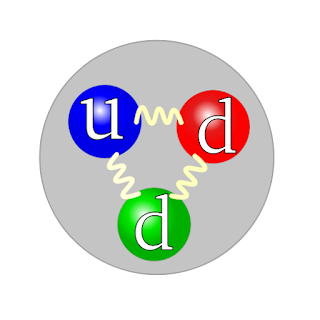
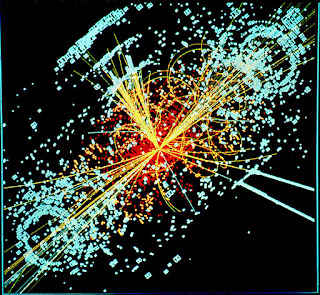



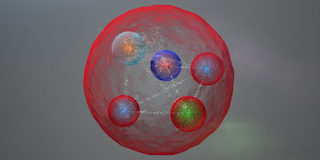

No comments:
Post a Comment